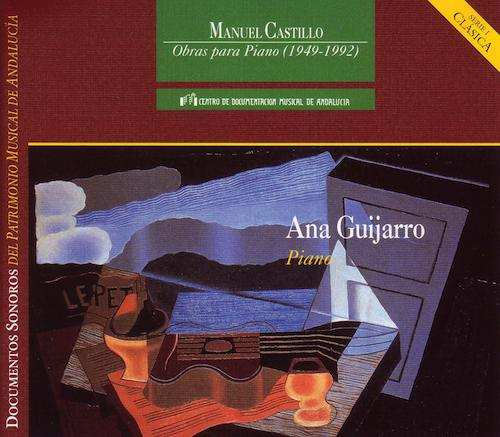Obras para Piano (1949-1992)
Detail DS - 0119 You can buy this record here 11 € Obras para Piano (1949-1992) Manuel Castillo
Manuel Castillo OBRAS PARA PIANO Ana Guijarro, Piano
1. Sonatina (1949) 8'12" 2. Toccata (1952) 5'34" 3. Tres piezas para Piano (1959) 6'46" 4. Preludio, Diferencias y Toccata (1959) 15'28" 5. Intimus (1986) 3'48" 6. Tempus (1980) 8'54" 7. Nocturno en Sanlúcar (1985) 4'46" 8. Sonata (1972) 15'10" 9. Perpetuum (1992) 6'32
TIEMPO TOTAL: 75'15" |
About MANUEL CASTILLO He was born in Sevilla in 1930. He was a student to A. Pantión and N. Almandoz, to A. Lucas Moreno y Conrado dei Campo in Madrid; to Lazare Levy and Nadia Boulanger in Paris. From 1995 he has worked as Professor of Piano and later on of Composition in the Conservatory "Manuel Castillo" of Sevilla, of which he was the headmaster from 1964 to 1978. Among the Prizes he has been awarded the most outstanding ones are the following: "Joaquín Turina", "Nacional de Música" 1959; "Manuel de Falla" (1975) and other granted for his choral works. In 1976 he was given the First "Reina Sofia" Grant for Composition. In 1980 his work "Suite Mediterranea" (Mediterranean Suite) was awarded the "Arpa de Plata" (Silver Harp). First "Premio Andalucía de Música" (Andalusia Music Prize). He is a permanent member of the "Real de Bellas Artes de Santa Isabel de Hungría de Sevilla" (Royal Academy of the Fine Arts of Santa Isabel of Hungary in Sevilla); member of the "Real de San Fernando de Madrid" (Royal Academy of San Fernando of Madrid) and of the “Bellas Artes de Granada" (Academy of the Fine Arts of Granada). In 1988 he was given the freedom of Andalusia. In 1990 he was awarded, for the second time, the "Premio Nacional de Música" (National Music Prize) as an appreciation of his work and artistic career. In 1994 H.M. the King has granted him the Medalla del Oro al Mérito en las Bellas Artes (Gold Medal to the Merit in the Fine Arts). His works, which comprise a variety of genders and already amounts to almost 150 scores, started with a style very close to nationalism. Later, it evolved to more universal and modern forms. A member of the Generation of 1951, it is difficult to include Castillo within the limits of a specific school since his music is independent and faithful to the inner transformations of its author, who is, nevertheless, much in touch with the various tendencies of contemporary music. These are some of his most outstanding works: PIANO: Sonatina, Suite, Toccata, Sonata, Prelude, Diferencias and Toccata, Three Concerts with Orchestra, Concert for Two Pianos and Orchestra. CHAMBER: Sonatas for Violín and Violoncello with Piano, Two Quintet Trío for Wind, Quintet with Guitar, Inventions, Variations on a theme by Mompou and Quartet No 1 for Strings. SONG: Children songs, Songs by Juan Ramón, Five Poems by Manuel Machado, Five Lorca Sonnets for Tenor and Orchestra. SYMPHONYC: Symphonies No 1, 2 and 3, :a Homage (M. De Falla), Concert for lo and Orchestra, Concert for Guitar and Orchestra. GUITAR: Sonata, Three Preludes. ORGAN: Suite, Prelude, Preliminary Notes and Fantasia for a Book on Organ. Sonata for Organ and Strings. Choral and Diferencias for Organ and Strings, Old Mode. CHORALS: Numerous harmonizings on Christmas carols and Andalusian folk songs, "Cantata del Sur", "Presencia Infantil" (Cantata). RELIGIOUS: Numerous motets, Hymns, Passion Antiphons, Corpus Christi Mass, etc. |

